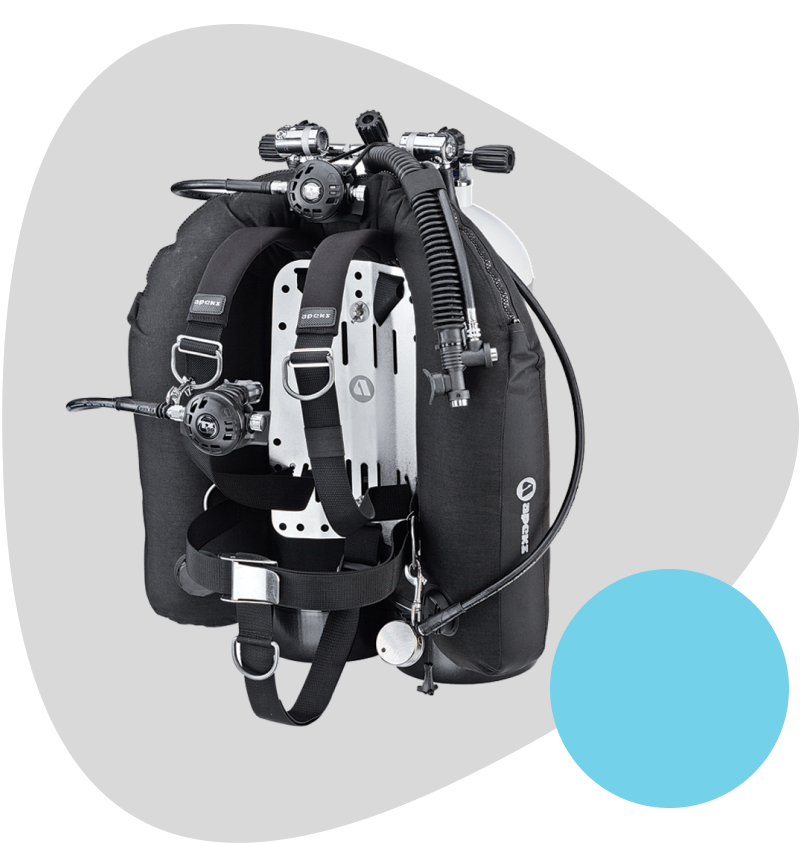Open Circuit
Technical diving opens the door to deeper, more complex underwater environments that are beyond the reach of recreational diving. For those who crave the challenge and adventure of exploring these realms, open circuit diving with twinset or sidemount configurations offers the versatility and safety required for such demanding dives.
Why Choose Technical Open Circuit Diving?
Technical diving involves going beyond the limits of recreational diving, often descending deeper, staying longer, and requiring more sophisticated equipment and training. The goal is to explore wrecks, caves, and other challenging environments that require meticulous planning and preparation. Open circuit systems, which include twinsets and sidemount configurations, are popular choices for technical divers due to their flexibility, redundancy, and the level of control they offer.
Twinset Configuration: The Classic Choice
The twinset, also known as a double tank setup, is the traditional configuration for technical diving. This setup involves two cylinders mounted on the diver’s back, connected by a manifold. The twinset provides several key advantages:
- Increased Gas Supply
The most obvious benefit of a twinset configuration is the increased gas supply, allowing for longer bottom times and the ability to carry multiple gas mixtures for different stages of the dive, such as bottom gas, travel gas, and decompression gas. - Redundancy and Safety
With a twinset, divers have two independent sources of air or nitrox, enhancing safety. The manifold allows divers to isolate one tank in case of a failure, ensuring they still have access to a full cylinder of gas. - Stability and Balance
When properly set up, a twinset provides excellent stability and balance in the water, which is crucial for maintaining buoyancy control during complex dives.
Sidemount Configuration: Flexibility and Freedom
Sidemount diving, originally developed for cave diving, has become increasingly popular in technical diving due to its flexibility and ease of access to cylinders. In sidemount, the cylinders are mounted on the diver’s sides rather than the back, offering several unique benefits:
- Streamlined Profile
Sidemount diving allows for a more streamlined profile, reducing drag and making it easier to maneuver in tight spaces such as caves or wrecks. This is especially advantageous in environments where space is limited. - Ease of Cylinder Management
With sidemount, divers can easily monitor and access their cylinders, which are positioned within reach. This makes it simpler to manage gas consumption, switch tanks, and deal with any potential issues during the dive. - Comfort and Adaptability
Sidemount configurations can be more comfortable for some divers, particularly those with back issues, as the weight is distributed along the sides rather than concentrated on the back. Additionally, sidemount setups are highly adaptable and can be used with various cylinder sizes, making it a versatile option for different dive profiles. - Enhanced Redundancy
Like the twinset, sidemount diving offers built-in redundancy. With independent regulators on each cylinder, divers have immediate access to a backup air source, adding an extra layer of safety.
Choosing the Right Configuration for Your Dive
The decision between a twinset and a sidemount configuration often comes down to personal preference and the specific requirements of the dive. Twinsets are ideal for deep, open-water dives where stability and a large gas supply are paramount. Sidemount, on the other hand, shines in confined environments like caves and wrecks, where maneuverability and ease of access to equipment are critical.
The Path to Technical Diving
Whether you opt for a twinset or sidemount configuration, technical diving requires a significant investment in training, equipment, and experience. Divers must be skilled in gas management, decompression procedures, and emergency protocols. The rewards, however, are immense—technical diving allows you to explore some of the most awe-inspiring and rarely seen places on earth.
For those ready to take the plunge, technical open circuit diving with twinset or sidemount configurations offers the tools and capabilities needed to safely and confidently push the limits of underwater exploration.


